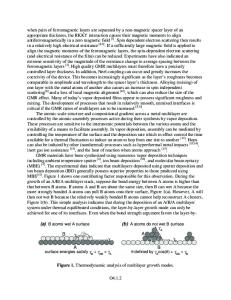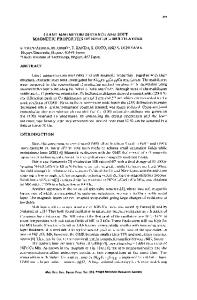Giant Magnetoresistivity in Electrochemically Produced Cobalt-Copper Multilayers
- PDF / 511,976 Bytes
- 10 Pages / 414.72 x 648 pts Page_size
- 17 Downloads / 328 Views
DAVID S. LASHMORE AND SUSAN Z. HUA Materials Innovation, 8 Commerce Avenue, West Lebanon, New Hampshire 03766-2009, [email protected]
ABSTRACT The electrodeposition of cobalt-copper multilayers will be described and the dependence of their magnetoresistivity on layer thickness and deposition parameters will be presented. For a wide variety of layer thicknesses electrochemically produced Co(Cu)-Cu thin polycrystalline layered alloys exhibit a giant magnetoresistivity (GMR). Further, upon annealing, the materials undergo a combination of grain growth and grain boundary diffusion. At certain conditions, this phenomena is believed to lead to a break up of the layered structure so that a magnetostatic coupling occurs and contributes to the GMR behavior. It is further shown that, by careful control of the deposition parameters, a quasilinear GMR response (low sensitivity) can be created over a large magnetic field or, conversely, a high sensitivity material can be grown, although at the sacrifice of introducing hysteresis in the response curve. The major deposition parameter affecting this behavior is mass transport in the electrolyte; however, substrate grain size, layer spacing and annealling history also play an important role. INTRODUCTION Giant Magnetoresisitivty was first observed by Baibich1 et. al. in multilayers of Fe-Cr produced by MBE technology. Since then a very large number of studies of GMR in multilayered metals 2,3 and recently ceramics 4 , have been reported. These studies have mainly focused on specimens prepared by physical vapor deposition techniques, such as MBE or sputtering. Electrochemically produced multilayers of very high quality are now being studied and have revealed a number of important aspects of the physics of thin films multilayers. For example in 1986, Lashmore, Oberle and Melmed5 demonstrated using Field Ion Microscopy, that for the copper-nickel system, copper grows epitaxially on nickel. Single crystal superlattices of Ni(Cu)Cu of all three principle orientations were first electrochemically grown by Lashmore and Dariel 6. A new and unexpected magnetic viscosity or after effect was discovered in these single crystal specimens by Bennett et. al.7 . This effect surprisingly increases as the temperature of the specimens is reduced to 200 °K. This effect was later found in sputtered specimens of the same composition and spacing. The first evidence of a four fold crystalline anisotropy in a single crystal (100) cobalt-copper electrochemically produced multilayer was shown by McMichael et al. '. These specimens showed at least 4th order satellites in the high angle X-ray diffraction patterns futher demonstrating their high quality. Alper et. al. in Bristol were the first to show GMR behavior in the Co-Ni(Cu)-Cu system9 . The magnetic domains in electrochemically produced CoNiCu-Cu multilayers were studied using Lorentz electron microscopy by Hua st. al. 10 ., who presented the first direct evidence of antiferromagnetic coupling in this system. Oscillatory GMR 161 Mat. Res. Soc
Data Loading...










